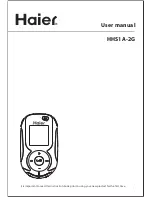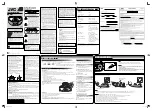
Getting Started
3
Ge
tting S
tar
ted
1
CAUTION:
•
The apparatus should not be exposed to water
(dripping or splashing) and no objects filled with
liquids, such as vases, should be placed on the
apparatus.
•
Minimum distances around the apparatus for
sufficient ventilation, no less than 5 cm.
•
The ventilation should not be impeded by
covering the ventilation openings with items,
such as newspapers, table-cloth, curtains etc.
•
No naked flame sources, such as lighted candles,
should be placed on the apparatus.
•
Internal lithium battery in the unit should not be
replaced by user because of danger of explosion
if battery is incorrectly replaced ,and must be
replaced with the same type battery by expert.
•
Use the apparatus in tropical and moderate cli-
mates only.
•
The excessive sound pressure from earphones
and headphones can cause hearing loss.
Caution of usage in the car
•
To prevent electrical shock and possible damage
to your unit or vehicle, always unplug the
automotive adapter from the cigarette lighter
socket before you remove the plug from your
unit.
•
A 3 amp. 250 V fuse for protection is installed in
the automotive adapter.
•
While the engine is being started, disconnect
the automotive adapter from the car’s cigarette
lighter socket.
•
Do not operate your unit when the car battery is
discharged. Peak current from the car generator
may cause the DC fuse to blow.
•
If the vehicle’s supply voltage drops below
approximately 10 volts, your unit may not work
properly.
•
Do not leave your unit in a place where the
temperature exceeds 45 °C (113 °F), or the pick-
up device may be damaged.
Disposal of your old appliance
1. When this crossed-out wheeled bin
symbol is attached to a product it
means the product is covered by the
European Directive 2002/96/EC.
2. All electrical and electronic products
should be disposed of separately
from the municipal waste stream
via designated collection facilities
appointed by the government or the
local authorities.
3. The correct disposal of your old
appliance will help prevent potential
negative consequences for the
environment and human health.
4. For more detailed information about
disposal of your old appliance, please
contact your city office, waste disposal
service or the shop where you
purchased the product.
Disposal of waste batteries/
accumulators
1. When this crossed-out wheeled
bin symbol is attached to batteries/
accumulators of Your product it means
they are covered by European Directive
2006/66/EC.
2. This symbol may be combined with
chemical symbols for mercury(Hg),
cadmium(Cd) or lead(Pb) if the battery
Contains more that 0.0005% of
mercury,0.002% of cadmium or 0.004%
of lead.
3. All batteries/accumulators should be
disposed separately from the municipal
waste stream via designated collection
facilities appointed by the government
or the local authorities.
4. The correct disposal of Your old
batteries/accumulators will help
to prevent potential negative
consequences for the environment,
animal and human health.
5. For more detailed information
about disposal of Your old batteries/
accumulators, please contact Your city
office, waste disposal service or the
shop where You purchased the product.




































